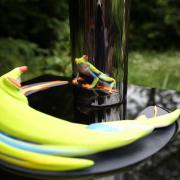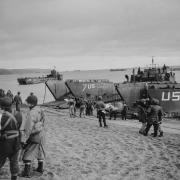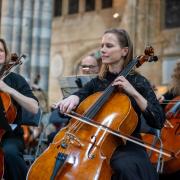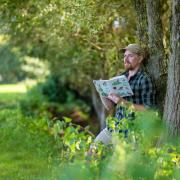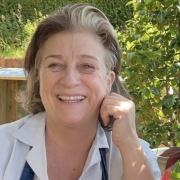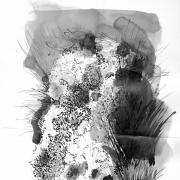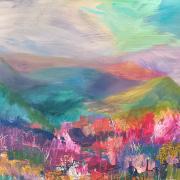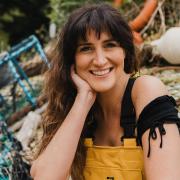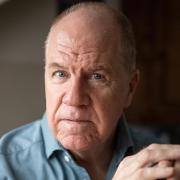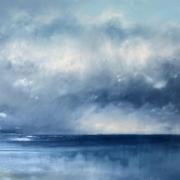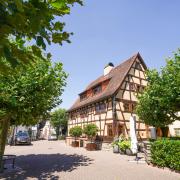Landscape artist Maria Floyd studied in London at two of the most prestigious art schools in the UK, graduating from Goldsmiths College and completing specialist courses at the Chelsea College of Art. She now lives and works in Tavistock on the edge of Dartmoor, making paintings and drawings inspired by her love of the unique landscape of the South West.
She is notable as an ‘en plein air’ artist, working outside with paint, ink, charcoal and chalk in the dramatic setting of Dartmoor national park, and on the Devon and North Cornwall coast, before refining and extending her collections back in the studio.
'My work follows the tradition of expressive landscape painting in the South West,' says Maria, in reference to her exceptional talent with expressive mark making and powerful composition. 'By using gestural interpretation, I try to capture the power and force of the elements. The energy of my marks mirrors the energy and force of ocean waves, or the wind whistling across the moor.'

In a quote which neatly encapsulates the very purpose of visual art across the centuries, she tells me: 'I use paint where it’s hard to find words.'
By building up her work in layers, whilst simplifying form and composition, Maria takes what is literal and pushes it towards an abstraction which better describes the sensory experience of outdoor places.
'Drawing outside enables my work to have a strong beginning.' she explains. 'My work is a direct response to my situation in the landscape at a given time. I sit and awaken my senses to the immediate environment, looking around, and hearing sounds or reflecting on the silence.
'By spending time on the moor, or sitting on the cliffs, I can connect with my subject before I try and respond to it. I need to have experienced the moment, the spray of the sea on my face, the blustery wind around me, the sparkling sun on the sea, the sound of sheep in the fields, or shadows moving across the moor, before I put a mark on paper.
'Making preliminary drawings in situ is fundamental to my practice. I begin by using charcoal and chalk to map the first shapes, and I then apply ink and paint using palette knives, and a range of tools I find at the site - grasses or sticks, and feathers, to extend my range of marks.

'My work usually starts in a sketchbook, where I spend time searching for the right tone and composition using large brushes to keep my lines and forms loose and intuitive. Next, I will move onto larger paper and continue to work in the same way, often with the wind and rain making their mark on my work too. Keeping my work on the ground is a challenge – I always need to find some good rocks to weigh the paper down – but working in this way is really important to me because it gives the final painting or drawing a good foundation.'
Aloneness, too, and the private experience of a place is equally important to Maria’s practice.
'I feel a strong connection to the uninhabited landscape,' she says. 'A sense of an unspoilt world and the smallness of me beside a stormy ocean or wild moorland, and I try to express that feeling of wonder in my work. It makes me think of Turner landscapes, or ‘The Monk by the Sea,’ she tells me, referencing an early 19th century oil painting by German Romantic artist Caspar David Friedrich, in which a tiny, solitary figure can be seen amid a swirling expanse of land, sea and sky.
'I have always found peace and comfort walking in uninhabited landscapes. From growing up walking the chalk paths of Berkshire as a child, I now walk the North Atlantic Coast and the wild expanse of Dartmoor, following ancient paths and the old ways across the land, feeling the sense of history, and connection to the ground beneath my feet. I feel strongly about the environment and the need to protect our natural world, and in my work I try to portray the strength, but also the fragility, in the balance of nature.'
When Maria brings her ‘plein air’ drawings back to the studio, she continues to work on large paper on the floor, or on a canvas. 'I use oil paint in the studio, allowing the paint to take on a language of its own, and when I stand back and consider the piece, I will question whether it resonates with the intention of those beginning sketches. If not, I will continue, sometimes for months, until it does, until the image finds its own language and rhythm.'

In preparation for a new exhibition at the Linney of the Cider House, in the grounds of Buckland Abbey this summer, Maria is currently putting together her very first series of works in response to the rivers of Dartmoor.
She tells me: 'I am drawn to water, to its energy, its depth of colour and the world of life within it. There are many rivers and small streams across Dartmoor, and my new project responds to water tumbling over rocks and the sounds of flowing streams giving life to the moorland. I want those who view my work to see a fleeting moment captured, to reflect on the power of the natural world, and to get a sense of place by interpreting my abstraction in their own way.'
See Maria Floyd’s new River collection this August at the National Trust’s Buckland Abbey, Yelverton, PL20 6EY. See nationaltrust.org.uk and mariafloydart.com




